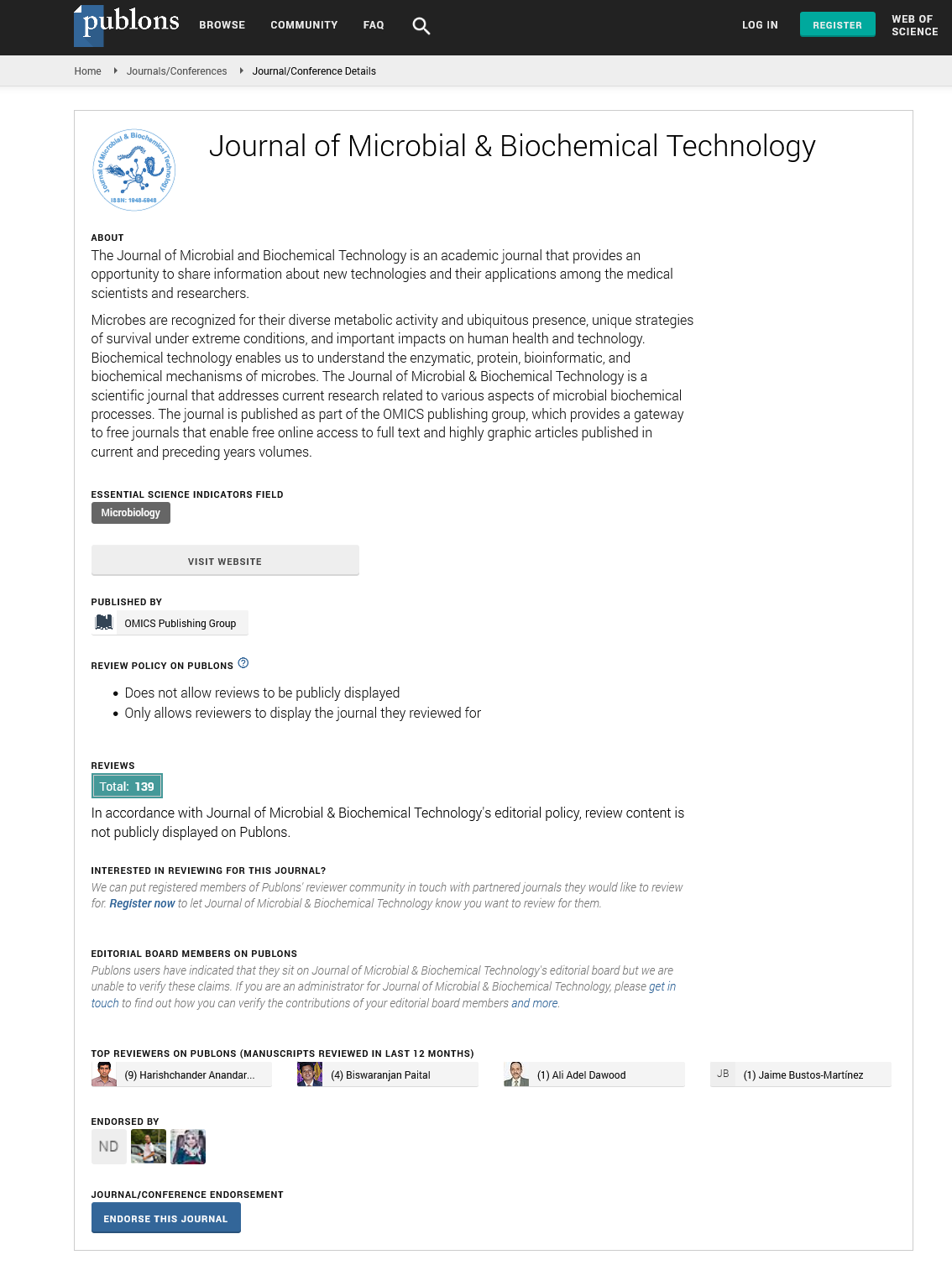Indexed In
- Academic Journals Database
- Genamics JournalSeek
- Academic Keys
- JournalTOCs
- China National Knowledge Infrastructure (CNKI)
- Scimago
- Access to Global Online Research in Agriculture (AGORA)
- Electronic Journals Library
- RefSeek
- Directory of Research Journal Indexing (DRJI)
- Hamdard University
- EBSCO A-Z
- OCLC- WorldCat
- SWB online catalog
- Virtual Library of Biology (vifabio)
- Publons
- MIAR
- University Grants Commission
- Geneva Foundation for Medical Education and Research
- Euro Pub
- Google Scholar
Useful Links
Share This Page
Journal Flyer

Open Access Journals
- Agri and Aquaculture
- Biochemistry
- Bioinformatics & Systems Biology
- Business & Management
- Chemistry
- Clinical Sciences
- Engineering
- Food & Nutrition
- General Science
- Genetics & Molecular Biology
- Immunology & Microbiology
- Medical Sciences
- Neuroscience & Psychology
- Nursing & Health Care
- Pharmaceutical Sciences
Perspective - (2025) Volume 2, Issue 1
Microbial Volatile Organic Compounds: Biochemical Signatures and Applications
Alexandre Van*Received: 14-Nov-2023, Manuscript No. JMBT-23-23896; Editor assigned: 17-Nov-2023, Pre QC No. JMBT-23-23896 (PQ); Reviewed: 01-Dec-2023, QC No. JMBT-23-23896; Revised: 03-Jan-2025, Manuscript No. JMBT-23-23896 (R); Published: 13-Jan-2025
Description
Microbial Volatile Organic Compounds (mVOCs) are a diverse group of small molecules produced by microorganisms as metabolic byproducts. These compounds play a crucial role in mediating microbial interactions, influencing ecological niches, and serving as potential biochemical signatures for microbial identification. Moreover, the unique properties of mVOCs have led to their exploration in various applications, ranging from agriculture and environmental monitoring to medical diagnostics.
Biochemical signatures of mVOCs
Microorganisms release a wide array of volatile organic compounds into their surroundings, reflecting their metabolic activities and physiological states. These compounds include alcohols, aldehydes, ketones, esters and terpenes, among others. The specific profile of mVOCs produced by a microorganism can serve as a distinctive biochemical signature, aiding in the identification of microbial species.
The production of mVOCs is influenced by factors such as nutrient availability, environmental conditions, and the presence of other microorganisms. For instance, some bacteria release mVOCs as a means of communication to establish cooperative or competitive interactions with neighboring microbes. The diversity and specificity of mVOCs produced by different microorganisms provide a unique fingerprint that can be utilized in microbial ecology studies and environmental monitoring.
Applications of mVOCs
Agricultural practices: mVOCs have shown potential applications in agriculture, where they can be used for pest management and crop protection. Certain mVOCs act as signaling molecules that attract or repel pests, serving as natural alternatives to synthetic pesticides. Additionally, mVOCs produced by beneficial microorganisms can enhance plant growth and confer resistance to diseases.
Environmental monitoring: The analysis of mVOCs in the air and soil can serve as a valuable tool for environmental monitoring. Changes in the composition and concentration of mVOCs can indicate shifts in microbial communities or the presence of pollutants. This approach offers a non-invasive and sensitive means of assessing environmental health and identifying potential risks.
Medical diagnostics: The unique mVOC profiles produced by pathogenic microorganisms have led to their exploration in the field of medical diagnostics. Breath analysis, in particular, has gained attention for its non-invasive nature and potential applications in the early detection of infectious diseases. Specific mVOC patterns associated with bacterial or fungal infections could serve as diagnostic markers, facilitating rapid and accurate disease diagnosis.
Bioremediation: Some microorganisms release mVOCs with the capability to degrade or transform pollutants. These compounds can be harnessed in bioremediation processes to enhance the removal of contaminants from soil and water. The use of mVOCs in bioremediation strategies offers a sustainable and environmentally friendly approach to address pollution issues.
Food quality and safety: The analysis of mVOCs in food products can provide insights into their quality and safety. Undesirable microbial activities, such as spoilage or contamination, can be detected based on the volatile compounds released. Monitoring mVOCs in food storage environments can also aid in the early detection of potential issues and help in the development of effective preservation strategies.
Conclusion
Microbial volatile organic compounds serve as biochemical signatures that reflect the metabolic activities and interactions of microorganisms. The exploration of mVOCs has led to innovative applications in various fields, including agriculture, environmental monitoring, medical diagnostics, bioremediation and food safety. As research in this area continues, the understanding of the diverse roles and applications of mVOCs is expected to expand, contributing to the development of sustainable and effective solutions in diverse domains.
Citation: Van A (2025) Microbial Volatile Organic Compound: Biochemical Signatures and Applications. J Microb Biochem Technol. 17:635.
Copyright: �© 2025 Van A. This is an open-access article distributed under the terms of the Creative Commons Attribution License, which permits unrestricted use, distribution, and reproduction in any medium, provided the original author and source are credited.

